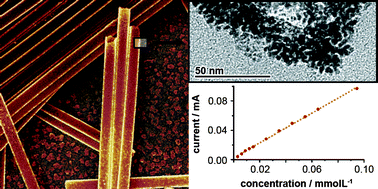Fabrication of porous rhodium nanotubecatalysts by electroless plating
Abstract
A versatile electroless plating procedure for the fabrication of rhodium nanomaterials was developed, leading to deposits consisting of loosely agglomerated metal

* Corresponding authors
a
Department of Materials and Geoscience, Technische Universität Darmstadt, Petersenstraße 23, 64287 Darmstadt, Germany
E-mail:
muench@ca.tu-darmstadt.de
b Institute of Nanotechnology, Karlsruher Institut für Technologie (KIT), Hermann-von-Helmholtz-Platz 1, 76344 Eggenstein-Leopoldshafen, Germany
c Institute for Applied Materials, Karlsruher Institut für Technologie (KIT), Hermann-von-Helmholtz-Platz 1, 76344 Eggenstein-Leopoldshafen, Germany
A versatile electroless plating procedure for the fabrication of rhodium nanomaterials was developed, leading to deposits consisting of loosely agglomerated metal

 Please wait while we load your content...
Something went wrong. Try again?
Please wait while we load your content...
Something went wrong. Try again?
F. Muench, C. Neetzel, S. Kaserer, J. Brötz, J. Jaud, Z. Zhao-Karger, S. Lauterbach, H. Kleebe, C. Roth and W. Ensinger, J. Mater. Chem., 2012, 22, 12784 DOI: 10.1039/C2JM31110K
To request permission to reproduce material from this article, please go to the Copyright Clearance Center request page.
If you are an author contributing to an RSC publication, you do not need to request permission provided correct acknowledgement is given.
If you are the author of this article, you do not need to request permission to reproduce figures and diagrams provided correct acknowledgement is given. If you want to reproduce the whole article in a third-party publication (excluding your thesis/dissertation for which permission is not required) please go to the Copyright Clearance Center request page.
Read more about how to correctly acknowledge RSC content.
 Fetching data from CrossRef.
Fetching data from CrossRef.
This may take some time to load.
Loading related content
